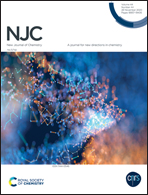Zeolite-based catalytic micromotors for enhanced biological and chemical water remediation†
Abstract
Zeolite-based micromotors were developed to eliminate the biological and chemical contamination of water in a fast and efficient way. The motors consist of a silver-exchanged zeolite core and a partial catalytic coating. These porous engines showed rapid killing of Pseudomonas aeruginosa bacteria cells in a very short time, less than 7.5 minutes. The heavy metal uptake of the zeolitic motors during the first 20 minutes of contact was considerably higher than that of zeolite particles by 23% for Pb2+, 19% for Co2+, and 16% for Ni2+. Also, the maximum removal efficiency of the motors (at room temperature and for 6 hours) for Pb2+, Co2+, and Ni2+ was 93%, 87%, and 78%, respectively, higher than that of the zeolite particles. The newly synthesized motors benefit from the adsorption capacity and antibacterial activity of silver-zeolites in combination with the autonomous propulsion of catalytic micromotors. The remarkable bactericidal capacity of these particles relies on the catalytic activity of the platinum coating and slow release of the reactive silver ions during movement that increases the chance of contact with bacteria. Finally, the authors believe that the development of zeolite-based micromotors provides a new effective strategy for both bacteria-killing and removal of heavy metal in the water purification process.



 Please wait while we load your content...
Please wait while we load your content...